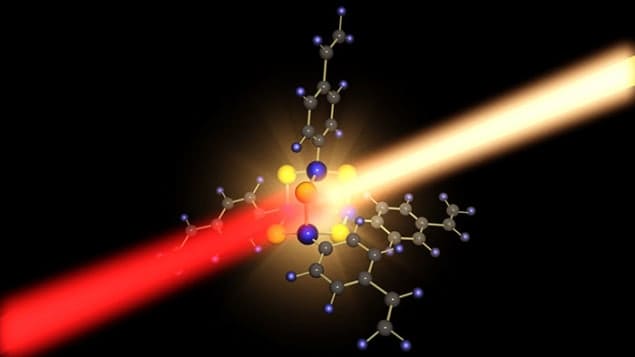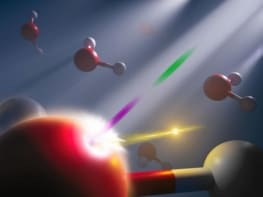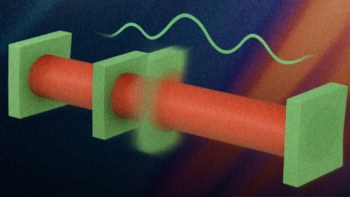
A new way to make broadband white light using a cheap, portable infrared diode laser has been developed by researchers in Germany. The technology uses nonlinear effects in a specially designed, easily produced, amorphous material to convert the infrared radiation into broadband visible light. The emitted light is also exceedingly directional, making it useful for high-spatial-resolution devices such as microscopes. It could also have applications in everything from lighting displays to projection systems.
The old-fashioned incandescent light bulb radiates evenly in all directions, and its newer, more efficient counterpart, the light-emitting diode (LED), sends light in all forward directions. This is useful for illuminating a room or a television, but applications such as light shows and microscopy require directional illumination.
Lasers are extremely tightly focused, but they also provide near-single-wavelength illumination, which is often undesirable – it gives a very unnatural image under a microscope, for example. Technologies currently available to provide a tightly focused beam of white light rely on nonlinear effects in, for example, photonic-crystal fibres. To excite these effects, high laser powers are required, which adds massively to the cost and energy requirements of the technologies.
Excited electrons
A new solution has now been developed by Stefanie Dehnen, Sangam Chatterjee and colleagues at the Philipp University of Marburg in Germany, who have synthesized a phosphor (a material that emits one wavelength when irradiated by another) comprising tin-sulfide surrounded by organic groups. When exposed to infrared radiation, the delocalized electrons surrounding the tin-sulfide core absorb the light and become excited. If they used a crystalline molecule, says Chatterjee, the light would be similar to that from a green laser pointer.
Crucially, however, the molecule synthesized by Dehnen’s group remains structurally amorphous – it is a white powder – with the organic groups randomly oriented. In this environment, there is no single lattice constant or vibrational frequency, so the light emitted does not have one pure frequency but is instead broadband. “Maybe certain atoms or certain types of molecules are corresponding somehow,” explains Dehnen, “But in this situation, you have a lot of different types of conformation and they will all give you another wavelength out.”
As the nonlinear effects were much easier to excite in their molecules than in photonic crystal fibres, the team found that powerful fibre lasers usually used could be replaced by simple diode ones. “[White-light] sources are available,” says Chatterjee, “But the laser is more on the $20,000–100,000 range, and our laser is more on the $3 range!” The researchers are continuing to investigate the details of the physics underlying the light conversion. They are also screening other similar compounds to ascertain whether any of them are more efficient or stable, and are investigating how to process the material most effectively. “White powder is bad from an optics point of view because white powder means scattering,” says Chatterjee. “That’s something we need to get under control – how to make this into a nice glass.”
Competing potentials?
Device-physicist E Fred Schubert of Rensselaer Polytechnic Institute in the US, who was not involved in the research, describes it as “a nice piece of work and an alternative path to create white light,” adding that its industrial promise “may show in the future”. He is sceptical, however, about the technology’s potential to compete with solid-state lighting. According to Schubert, organic phosphors have fallen out of favour because they lack the stability to tolerate high radiation fluxes.
He also questions the researchers’ description of their phosphor as “highly efficient”, saying that, while the 10% efficiency of their phosphor is high compared with other upconverting phosphors (phosphors that give out higher frequencies that they absorb), solid-state lighting uses downconverting phosphors with much higher efficiencies. “Before device people look at a phosphor, it has to have more than 90% efficiency,” he says. Finally, he says that display lighting normally requires “control of colour” rather than just broadband, white illumination.
The research is published in Science.



